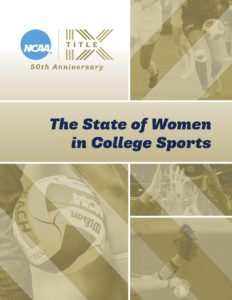Fifty Years After Title IX, We Are Very Far From Gender Equity in College Athletics
Posted on Jun 29, 2022 | Comments 0
 A new report published by the National Collegiate Athletic Association documents the state of women’s college sports 50 years after the enactment of Title IX.
A new report published by the National Collegiate Athletic Association documents the state of women’s college sports 50 years after the enactment of Title IX.
“Now is an important time to take inventory on where we’ve seen progress across college sports,” said Amy Wilson, NCAA managing director of inclusion and the author of the NCAA’s Title IX at 50 report. “Though we’ve made gains in certain areas, we obviously still have work to do. The 50th anniversary of Title IX is a time to celebrate all that’s been done and the accomplishments of so many important figures, but it’s also an occasion to identify where we need extra attention in the future.”
Throughout the 2000s, participation rates for male student-athletes slightly outpaced those for females. From 2002 to 2020, men gained nearly 73,000 participation opportunities, while women gained over 67,000. In the NCAA’s Divison 1, women now make up 47.1 percent of all student athletes. Yet 54 percent of all students in Division 1 schools are women.
The gender gaps in other areas remain very large.
Women hold approximately 25 percent of all NCAA head coaching and athletics director positions and 30 percent of conference commissioner positions. In 2019-20, men were head coaches of 58.7 percent of women’s teams. In contrast, women have had meager increases in opportunities to coach men, holding only 5.8 percent of head coaching positions for men’s teams.
An analysis of total expenses indicates that Division I athletics departments are generally spending twice as much on their men’s programs than on their women’s programs. And the gap in Division 1 has grown in recent years. The difference between median total expenses for men’s and women’s programs at Football Bowl Subdivision schools has grown from $12.7 million in 2009 to $25.6 million in 2019.
Filed Under: Research/Study • Title IX








